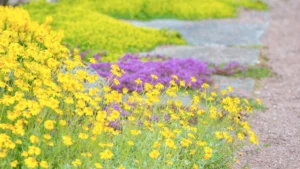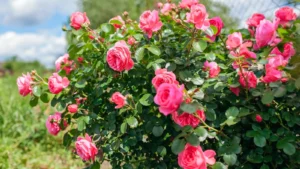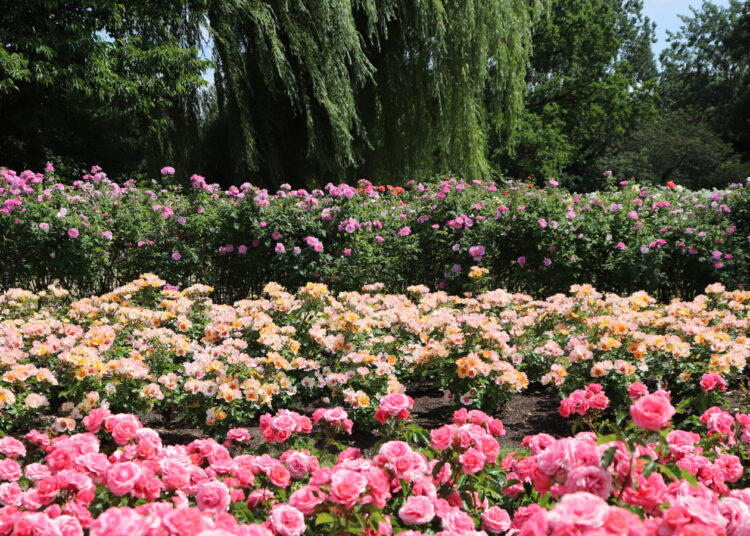A thriving rose garden is often the centerpiece of any landscape, and the addition of a thoughtful ground cover can elevate its beauty while providing practical benefits. Ground cover for roses serves more than just an aesthetic purpose—it protects the soil, retains moisture, and keeps weeds at bay. By choosing the right ground cover, you can create a harmonious and flourishing garden that impresses every visitor.
In this guide, we’ll explore what ground cover for roses entails, its numerous benefits, and how to choose, plant, and care for it effectively. Let’s dig in!
What Is the Ground Cover of a Rose?

Ground cover for roses refers to low-growing plants that spread across the soil beneath and around rose bushes. These plants act as a living mulch, shielding the soil from harsh environmental conditions, retaining moisture, and suppressing weed growth.
In addition to their functional purposes, ground covers provide a visually appealing base that complements the elegance of rose blooms. They create a layered effect in your garden, drawing attention to the roses while adding a lush, natural charm.
Benefits of Using Ground Cover for Roses
- Soil Moisture Retention: Ground cover plants reduce evaporation, helping the soil retain moisture longer. This is particularly beneficial for rose bushes, which thrive in consistently moist but well-draining soil.
- Weed Suppression: By covering exposed soil, ground covers minimize the space available for weeds to grow. This means less time spent weeding and more time enjoying your garden.
- Erosion Prevention: In sloped gardens or areas prone to erosion, ground cover helps stabilize the soil and prevent nutrient loss, ensuring your roses receive the nourishment they need.
- Enhanced Visual Appeal: A carpet of green or flowering plants under your roses can transform the look of your garden, creating a seamless and cohesive design.
- Biodiversity and Pollinator Attraction: Many ground cover plants attract beneficial insects like bees and ladybugs, which can help keep pests in check and pollinate your roses.
What Is the Best Ground Cover Rose?
When selecting the best ground cover rose, consider varieties that are hardy, low-maintenance, and offer extended blooming periods. Here are a few popular choices:
- Flower Carpet Roses: Known for their vibrant colors and disease resistance, these roses are perfect for creating a dense, flower-filled ground cover.
- Drift Roses: Compact and spreading, Drift Roses come in various shades and are ideal for smaller gardens or spaces with limited ground area.
- Sea Foam Roses: These roses produce cascading blooms and are well-suited for covering large areas.
- Meidiland Roses: With excellent disease resistance and abundant blooms, these roses are a reliable choice for ground cover.
When selecting a variety, consider your garden’s climate, soil conditions, and the level of maintenance you’re willing to commit to.
How to Choose the Right Ground Cover for Your Garden

Selecting the perfect ground cover involves balancing functionality with aesthetics. Here are some tips to guide your decision:
- Assess Your Garden’s Needs: Identify your garden’s unique challenges, such as weed growth, soil erosion, or water retention, and choose a ground cover that addresses these issues.
- Consider Maintenance Requirements: If you prefer a low-maintenance garden, opt for hardy and drought-tolerant ground covers like creeping thyme or sedum.
- Match Colors and Textures: Choose ground cover plants with complementary colors and textures to highlight the beauty of your roses without overpowering them.
- Ensure Compatibility: Verify that the ground cover plants won’t compete with your roses for nutrients or sunlight.
- Top Recommendations: In addition to ground cover roses, consider companion plants like lavender, alyssum, or creeping phlox, which pair beautifully with rose bushes.
Planting and Caring for Ground Cover Roses
Step-by-Step Guide to Planting:
- Prepare the Soil: Remove weeds and debris, then enrich the soil with organic compost.
- Space Appropriately: Follow the recommended spacing for your chosen ground cover to prevent overcrowding.
- Water Generously: Ensure the soil is moist during planting and keep it hydrated as the plants establish themselves.
- Mulch for Protection: Add a layer of organic mulch around the base to retain moisture and deter weeds.
Maintenance Tips:
- Watering: Water regularly, especially during dry spells.
- Pruning: Trim back overgrown sections to maintain a tidy appearance.
- Fertilizing: Use a balanced fertilizer to promote healthy growth for both the roses and the ground cover.
Common Mistakes to Avoid
- Overcrowding Roses and Ground Cover: Ensure there’s adequate airflow to prevent fungal diseases.
- Ignoring Compatibility: Avoid invasive ground covers that may compete with roses for resources.
- Skipping Soil Preparation: Poor soil conditions can stunt the growth of your ground cover and roses.
FAQs About Ground Cover for Roses
1. What is the purpose of ground cover for roses?
Ground cover for roses serves multiple purposes, including protecting the soil, retaining moisture, preventing weed growth, and enhancing the visual appeal of your garden. It also helps stabilize soil in sloped areas and creates a harmonious look.
2. Can any plant be used as ground cover for roses?
Not all plants are suitable as ground cover for roses. Ideal ground covers should be low-growing, non-invasive, and compatible with roses. Popular options include creeping thyme, sedum, and ground cover rose varieties like Drift Roses.
3. What are the best ground cover roses?
Some of the best ground cover roses include:
- Flower Carpet Roses: Known for their vibrant colors and disease resistance.
- Drift Roses: Compact and spreading, ideal for smaller gardens.
- Sea Foam Roses: A great choice for large areas with cascading blooms.
4. How do I choose the right ground cover for my roses?
Consider your garden’s climate, soil type, and aesthetic preferences. Opt for ground cover plants that complement your roses without competing for nutrients or sunlight. Low-maintenance options like creeping phlox and alyssum are great choices.
5. How do I plant ground cover around roses?
To plant ground cover around roses:
- Remove weeds and prepare the soil.
- Space the ground cover plants appropriately to allow room for growth.
- Water generously and mulch to retain soil moisture.
6. Can ground cover roses survive in all climates?
Ground cover roses are generally hardy but perform best in well-drained soil and areas with plenty of sunlight. Some varieties are more tolerant of specific climates, so choose a type suited to your region.
7. What are the maintenance requirements for ground cover roses?
Ground cover roses require regular watering, seasonal pruning, and occasional fertilization. Mulching around the plants can help retain moisture and suppress weeds.
8. Do ground cover plants attract pests to roses?
Some ground covers, like thyme or lavender, can repel pests and attract beneficial insects. However, overcrowding or improper maintenance can create conditions for pests or diseases.
9. Can I grow edible plants as ground cover for roses?
Yes, certain edible plants like herbs (e.g., thyme, oregano) can be used as ground cover for roses. These plants not only enhance garden aesthetics but also provide a functional harvest.
10. Is mulch a better option than ground cover for roses?
While mulch offers excellent moisture retention and weed suppression, living ground cover plants provide additional benefits like biodiversity, soil stabilization, and aesthetic appeal. Combining both can yield the best results.
11. How long does it take for ground cover roses to spread?

The spreading time varies depending on the variety, soil conditions, and care. Most ground cover roses start establishing themselves within a few weeks and can cover a large area in one to two growing seasons.
12. Can I mix different ground covers under my roses?
Yes, mixing ground covers can create a diverse and visually appealing garden. Ensure the chosen plants are compatible and won’t outcompete each other or your roses.
Conclusion
Ground cover for roses is more than a decorative feature—it’s a vital component of a healthy and sustainable garden. By selecting the right ground cover, you can protect your soil, reduce maintenance, and elevate the beauty of your roses. Whether you choose vibrant Flower Carpet Roses or resilient creeping thyme, the results will undoubtedly enhance your garden.
For more gardening tips and inspiration, visit GardenLoom and start transforming your outdoor space today!










